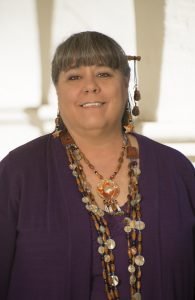#MediaMonday – Deb Krol

HMA has a long history of working with tribal governments and Native American enterprises across the Southwest. We’ve worked with mainstream and Indian Country media outlets regarding issues impacting the Native American communities.
Deb is an enrolled member of the Xolon (also known as Jolon) Salinan Tribe from the Central California coastal ranges and tells anyone who asks that her “beat is Indians.”
So, Deb, time to share!
I guess you could say my career in words started when I was 4, a Jolon Indian kid growing up in San Lucas, Calif. I used to beg my grandmother to read to me, which she did—but one day, she sighed and said, “Debbie, I think you need to learn how to read yourself.” So, she taught me using the whole language method, by pointing at a word and repeating it. Over, and over, and over. I worked hard to memorize each word. Soon, the neighbors would sweep me down the two blocks from our home to Donn Bunte’s General Store, which also housed the only gas station and post office in town, plopped on the bench out front and handed the day’s copy of the San Francisco Chronicle. “See, this little girl can read the paper!” the folks remarked. (I’ve always held a soft spot for the Chronicle, since its ink-stained newsprint showed me the way to my true career – writing).
That led to my first writing credit at age 6: I carefully wrote out and mailed a riddle to “Captain Cosmic’s Cartoon Show” at KSBW-TV in Salinas. I not only got to hear my riddle read on the air but I received my first writing payment—a giant Tootsie Roll packed full of candy. This writing gig was looking pretty good! But fate intervened, when my elders steered me away from writing, averring that I’d starve.
I went on to a career in electronics and later, writing up airplanes after moving to Arizona. But I never forgot writing.
After going to college the second time, I finally discovered a way to satisfy that urge. I took a job as the public information officer at the Arizona Commission of Indian Affairs, a state agency. Most of my job was writing—but I still wanted more. I moved on to managing a tribal newspaper and then to the Heard Museum, where I did marketing and wrote lots of collateral. But, all the time, I was freelancing on the side, doing my best to smash the stereotypes that surround Indians [I generally use Indian or the person’s tribe for identifiers, but I use Native American, too]. I wrote for everybody I could, including Arizona Capitol Times, Native Peoples Magazine, Indian Country Today, Madden Media’s publications and other venues.
I then moved on to an editorial job—and discovered that I’m not the editorial type. I’m a writer and a reporter, and that’s what I was meant to be. So, this year, I leapt off the cliff and started freelancing full time.
Now, I write for many venues on Native issues and, lately, mainstream issues, like what happened when I started working from home and disrupted my long-retired hubby’s routine for Prevention.com! However, I mainly portray Native peoples as the complicated, multicultural, misunderstood, artistic, political, business people we are, warts and all. That makes me a generalist of sorts—I like to say I’ll write most anything except play-by-play sports. Some people don’t do windows, I don’t do sports.
But, it’s hard to convince some editors that I’m capable of objectively reporting about my own community. It’s an issue that confronts many Native journalists, and we’re all a bit frustrated about how to deal with it—I mean, after all, if that were true, all the Anglo journalists would be disqualified as well! Fortunately, that hasn’t come up much with our local outlets, since Phoenix is what I like to refer to as “Indian Central,” with a large and visible urban Indian community. Our local editors have come to understand our complexity and nuances, which is wonderful for journalists like me.
I’m always looking for that next outlet to give me editorial space [and paychecks!] to do what I like to call “explaining Indians” to a world that direly needs some news that’s not fake about us. And I do appreciate our Phoenix PR community, which helps me find the subject matter experts to make my stories shine!
Follow me at @debkrol, facebook.com/debkrol, linkedin.com/debkrol, debrakrol.contently.com and [occasionally] on Instagram/debkrol [when I have newly completed jewelry to show off].
Photo credit: Craig Smith

